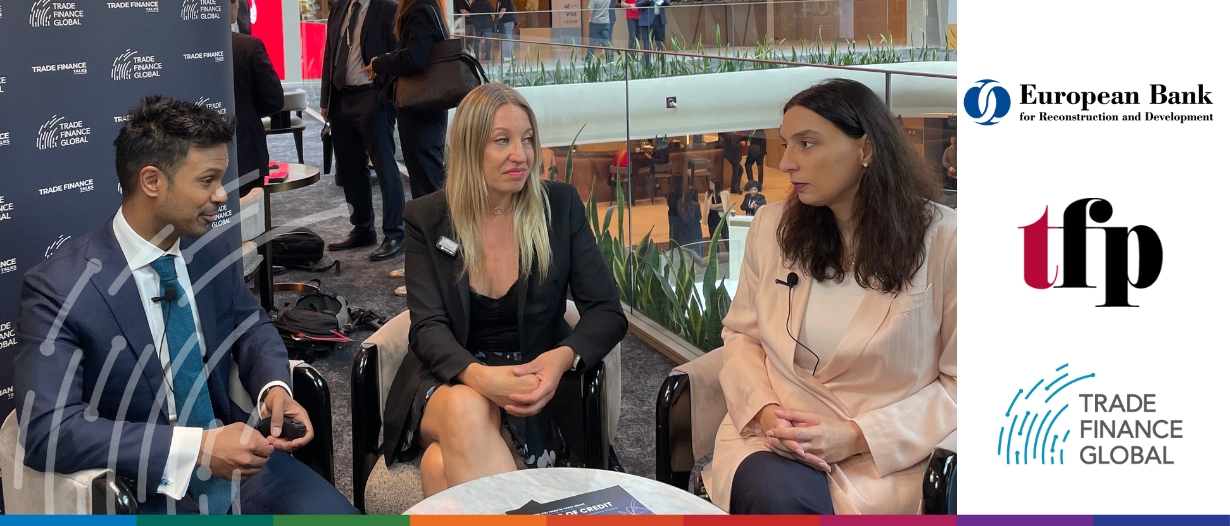Estimated reading time: 5 minutes
Sustainability and green financing are some of the most important topics within the international trade industry, yet actually implementing policies and strategies is extremely difficult.
Public-private partnerships are vital to creating a more sustainable future and improving the trade, treasury, and payments industry.
To learn more about the European Bank for Reconstruction and Development’s (EBRD) efforts in sustainability and the growing partnerships in this area, Trade Finance Global’s (TFG) Deepesh Patel (DP) spoke with Maya Hennerkes (MH), Director, Green Financial Systems, EBRD and Salome Tvalodze (ST), Head of Sustainable Finance Division at the National Bank of Georgia at the 2024 EBRD TFP Information Session and Awards Ceremony at the 33rd EBRD Annual Meeting and Business Forum in Yerevan.
DP: Maya, can you elaborate on the key strategies the EBRD employs to promote green financial systems?
MH: We do that in three ways.
The first is green finance. We’ve successfully greened almost all of our financial instruments, including trade finance.
Second, we work quite holistically with financial institutions to help them green their operations, green their risk management system, and green their entire climate governance.
Third is collaborating with regulators such as the National Bank in Georgia and many others on setting conducive policy environments for sustainability and ESG integration.
DP: Salome, can you describe the National Bank of Georgia’s Sustainable Finance Framework and its core components?
ST: The National Bank of Georgia, as the central bank, supports Georgia’s financial sector in achieving sustainable development, which is why we have developed our sustainable finance framework.
Through the framework, ESG considerations are integrated into financial decision-making, ESG risk management, and climate risk management, and financial flows are redirected towards more sustainable activities.
Over the years, we have introduced regulations, guidelines, and policies in all three main pillars of sustainable finance:
- Sustainable finance markets (which include taxonomies and definitions)
- ESG risk climate risk management (which requires related regulations and guidelines)
- Disclosure reporting and transparency.
Now that the bank has covered all this, we are moving more towards ensuring that the financial sector implements all these regulations.
DP: Maya, what role does policy support from financial regulators play in advancing green finance?
MH: It is crucial.
Central banks have a supervisory capacity within a country and know that climate risks can threaten a bank’s portfolios. This means they can be instrumental in supporting regulated banks in integrating climate risk.
If financial regulators create a conducive environment, it levels the playing field and means that all banks can speak the same language regarding ESG and climate risk integration.
That is going to help lift the entire system.
DP: Salome, how does the National Bank of Georgia collaborate with the private sector to drive sustainable finance initiatives in Georgia?
ST: Collaborating with the private sector is a core part of our sustainable finance framework development to develop sustainable finance in Georgia.
This collaboration is one of our success factors, and we continue to work very closely with them because it is essential to have the financial sector on board to be successful in this field.
They are involved in the whole process, from developing regulations to implementing them.
DP: Maya, what are the biggest hurdles currently facing the adoption of sustainable finance practices globally
MH: There are three main hurdles.
The first one is that there is a plethora of different climate, ESG, sustainability standards, regulations, and some voluntary, some compulsory. We need to converge these standards, especially at an international level because climate risks, as we all know, don’t stop at borders.
We are starting to see some convergence on the disclosure side with the ISSB at the international level; and in the European context with CSRD, which is a promising sign, but there needs to be much more.
The second hurdle is internal capacity. Dealing with environmental and social issues is not easy, and climate issues are quite complicated. Banks need to really build internal capacity. They’re already doing it, but it needs to continue.
The third is showing that there’s a business case for the green transformation. There is a lot of opportunity here, and the better we can show this business case, the more banks we will be able to attract.
DP: Maya, what advice would you give to financial institutions that are just beginning to explore green finance?
MH: Just start.
It seems very overwhelming because it’s such a multifaceted issue, but there’s so much to do, and given the climate urgency, we have a great urgency.
Just start somewhere.
DP: Salome, in your opinion, what will be the most significant change in green finance over the next decade?
ST: We will see green and sustainable finance become much more mainstream.
All types and sizes of financial institutions will move towards sustainable and green finance, not just the leaders of advanced institutions.
There are a few factors that contribute to this. Policy and regulation is definitely one of them because we see increasing regulations and policies.
Another factor be international pressure and international regulations, including the pressure from international financial institutions like the EBRD. They play a crucial role in advancing sustainable and green finance, especially in emerging countries.
Last but not least, there will be increased awareness about both risks and opportunities.
Green finance is not only managing risks, it is a huge opportunity. More and more financial institutions are realising this. They are risks they need to manage, and there are opportunities they need to use.
This increasing awareness will contribute to mainstreaming green and sustainable finance.























